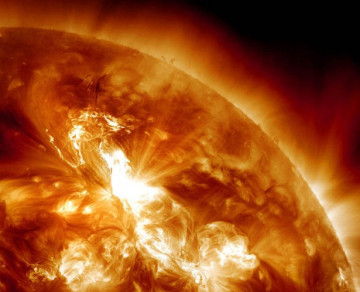Solar Flares
Saturday, March 10, 2012
With the increase in very energetic solar flares, I thought it was prudent to provide a basic primer on our Sun and the reasons for its recent outbursts.
Though our Sun is a very stable star, it does have a slight “variability.” Over an average 11-year cycle, solar activity rises from solar minimum, where no or few sunspots are visible, to solar maximum, where hundreds of sunspots can be counted. That peak activity then subsides back down to another solar minimum. We are now well on our rise to peak (solar maximum) during 2013.
Sunspots
Sunspots are actually depressions in the visible surface (photosphere) of the Sun which are cooler than the surrounding area. They get cool because very strong magnetic fields prevent hot material from welling up into the region from below the surface. The magnetic fields are in constant flux, and individual sunspots and groups of sunspots change over the course of a few hours.
GET THE LATEST BREAKING NEWS HERE -- SIGN UP FOR GOLOCAL FREE DAILY EBLASTThese magnetically active regions also produce prominences that loop above the solar surface, as well as the more explosive solar flares and coronal mass ejections (CME).
The active region that produced the recent activity was sunspot group AR1429. It was a very complex sunspot group. Magnetic fields can store a lot of energy. But like an elastic band, the magnetic field can snap. When that happens all the stored energy is released. These flares, which occur in the chromosphere above the sunspot group, eject large amounts of high-energy particles and gas into space at very fast speeds. They are also extremely hot, ranging from 3.6 million to 24 million degrees F.
Explosions in space
The flare also triggered a CME. The outer “atmosphere” of the Sun, called the corona, is also confined by very strong magnetic fields. When the flare exploded up into the corona, the sudden increase in energy caused the local coronal magnetic fields to be overwhelmed, and they too snapped and ejected even more energetic particles into space.
The CME was not precisely Earth directed, but we did receive a glancing blow from the stream of very energetic protons and electrons. It did not produce a severe geomagnetic storm, but northern lights displays (aurora) did occur at high latitudes. I have not heard of any satellite malfunctions, GPS problems, or power grid outages as a result of this event.
Based upon my analysis of several websites, it is possible that an aurora might have been visible from southern New England from Thursday night through Friday morning, but as usual clouds ruled the night. And yes, contrary to popular belief, aurora can be viewed from here.
It is more than likely that AR1429 will produce additional flares over the next few days, and with the group now more centrally located on the solar disk, any event will be Earth directed. And just as I was about to send this article off, it was reported another less intensive solar flare occurred causing another CME which is Earth directed. Be alert for reports of more geomagnetic storms and for more auroral displays. Who knows, we might get lucky and see one here in southern New England tomorrow night into Sunday morning.
A follow-up on how these solar storms actually produce the northern lights will appear in a future article.
For more Lifestyle coverage, don't miss GoLocalTV, fresh every day at 4pm and on demand 24/7, here.
Related Articles
- Mars Will Be Closest to Earth This Week
- Winter Constellations Over Rhode Island
- Winter Constellations and How to Find Them
- Looking for Venus in the Winter Sky



